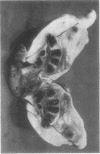Abstract
A further example of the rare disorder of embryonic development known as `foetus in foetu' is described. Extensive blood group determinations, using a new autoanalytical technique, were combined with chromosome studies to show that the chance of the foetus in foetu and its host being of monozygotic origin was 0·947.
Full text
PDF





Images in this article
Selected References
These references are in PubMed. This may not be the complete list of references from this article.
- CONSTANDOULAKIS M., KAY H. E. A and B antigens of the human foetal erythrocyte. Br J Haematol. 1962 Jan;8:57–63. doi: 10.1111/j.1365-2141.1962.tb06495.x. [DOI] [PubMed] [Google Scholar]
- GROSS R. E., CLATWORTHY H. W., Jr Twin fetuses in fetu. J Pediatr. 1951 Apr;38(4):502–508. doi: 10.1016/s0022-3476(51)80037-4. [DOI] [PubMed] [Google Scholar]
- JANOVSKI N. A. Fetus in fetu. J Pediatr. 1962 Jul;61:100–104. doi: 10.1016/s0022-3476(62)80236-4. [DOI] [PubMed] [Google Scholar]
- LEWIS R. H. Foetus in foetu and the retroperitoneal teratoma. Arch Dis Child. 1961 Apr;36:220–226. doi: 10.1136/adc.36.186.220. [DOI] [PMC free article] [PubMed] [Google Scholar]
- Lalezari P. A mew method for detection of red blood cell antibodies. Transfusion. 1968 Nov-Dec;8(6):372–380. doi: 10.1111/j.1537-2995.1968.tb02439.x. [DOI] [PubMed] [Google Scholar]
- Lamabadusuriya S. P., Atukorale A. W., Soysa P. E., Walpita P. R. A case of fetus in fetu. Arch Dis Child. 1972 Apr;47(252):305–307. doi: 10.1136/adc.47.252.305. [DOI] [PMC free article] [PubMed] [Google Scholar]
- Lee E. Y. Foetus in foetu. Arch Dis Child. 1965 Dec;40(214):689–693. doi: 10.1136/adc.40.214.689. [DOI] [PMC free article] [PubMed] [Google Scholar]
- Numanoglu I., Gokdemir A., Oztop F. Fetus in fetu. J Pediatr Surg. 1970 Aug;5(4):472–473. doi: 10.1016/0022-3468(70)90082-5. [DOI] [PubMed] [Google Scholar]
- SMITH S. M., PENROSE L. S. Monozygotic and dizygotic twin diagnosis. Ann Hum Genet. 1955 Jun;19(4):273–289. doi: 10.1111/j.1469-1809.1955.tb01354.x. [DOI] [PubMed] [Google Scholar]
- SPEISER P. [On the smallest human embryo studied up to the present time (27 mm. and 2.2 grams) in whose blood the hereditary features A1, M, N, s, Fy(a-plus), C, c, D, E, e, Jk(a-plus ?) could be detected]. Wien Klin Wochenschr. 1959 Jul 31;71:549–551. [PubMed] [Google Scholar]
- Toivanen P., Hirvonen T. Fetal development of red cell antigens K, k, Lua, Lub, Fya, Fyb, Vel and Xga. Scand J Haematol. 1969;6(1):49–55. doi: 10.1111/j.1600-0609.1969.tb01803.x. [DOI] [PubMed] [Google Scholar]






